
by John Cline
I talk to a lot of other miners, asking for different ways to do this or that. One observation that has surfaced is the importance of sampling. And, how many miners lack this practice. Many miners can “read” a river or creek, and some sample, but many don’t. This past year, I’ve talked to several miners who can’t understand why they are not finding gold. They are set up in a great looking location, they have moved many large boulders, they have cleaned the bedrock, but still very little gold. Well, believe it or not, they have been bitten by the gold bug. They have “gold fever,” they are working for all they have… but bottom line, recovering nothing for their effort. I have experienced this same frustration.
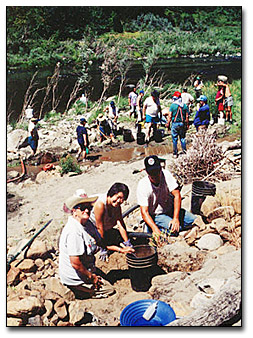 A couple of my friends and I set up our dredges in an area that looked great. Within the first hour, we knew that we were working someone else’s tailings. This area hadn’t been worked for ten years or so, but still we were in some tailings. We moved to our second location. We worked a hole for two days without success. Afterwards, we asked ourselves why we hadn’t found anything. We were in hard-pack, we found the red layer, we were on bedrock, but still nothing. When we asked some the local old timers why, their answer was “that’s gold mining” or “sometimes you find it and sometimes you don’t.” The real reason we did not harvest any fruit for our labor was that we had not sampled. Oh, we looked at the water flow and studied the river, but we had not sampled either location. It’s like working with our heads in the hole and not looking up to see which direction we’re going. When one climbs out of the hole, looks around and yells down to the others “We’re going in the wrong direction!” The others yell back “It doesn’t matter–we’re making good progress.”
A couple of my friends and I set up our dredges in an area that looked great. Within the first hour, we knew that we were working someone else’s tailings. This area hadn’t been worked for ten years or so, but still we were in some tailings. We moved to our second location. We worked a hole for two days without success. Afterwards, we asked ourselves why we hadn’t found anything. We were in hard-pack, we found the red layer, we were on bedrock, but still nothing. When we asked some the local old timers why, their answer was “that’s gold mining” or “sometimes you find it and sometimes you don’t.” The real reason we did not harvest any fruit for our labor was that we had not sampled. Oh, we looked at the water flow and studied the river, but we had not sampled either location. It’s like working with our heads in the hole and not looking up to see which direction we’re going. When one climbs out of the hole, looks around and yells down to the others “We’re going in the wrong direction!” The others yell back “It doesn’t matter–we’re making good progress.”
Webster’s definition of sampling: “…a part, piece, or item taken or shown as representative of a whole thing, groups, species, etc., specimen; pattern.” We sample all the time and really don’t give it a second thought. Recently my wife Marge and I were going out to dinner with our son David and future daughter-in-law, Daphne. And, we had a hard time deciding where to go. I suggested one place and they said it was a great place for lunch, but not so good for dinner. This happened several times and then we decided on a nice restaurant. Believe it or not, this is a form of sampling. David and Daphne eat out much more than we do, and in other words, they sampled for us.
In my last article I shared with you my experience with Dave McCracken and his weekend Group mining Projects. During the workshop Dave made two points over and over, which have made a considerable difference in mining for me. The first is being proactive and having a goal. The second was the importance of sampling. During the Project we had twenty-plus people sampling and formed a good picture of the area–where the gold was, and where it wasn’t. When you work by yourself or with a friend or two, you must create that picture.
- Basics of Successful Gold Mining, Part 1
- The Basics of Successful Gold Mining, Part 2
- Basics of Successful Gold Mining, Part 3
First, I believe that a sample hole when power sluicing (high banking) or dredging must have at least 50 square feet (5 feet x 10 feet) of bedrock cleaned. I feel that this should give us a fair sample of the potential for gold we should recover. We systematically take the hole apart by deciding the location that we will work, how big an area, and how deep we will go before testing the high-grade trap in our Pro-Mack High banker/Dredge Combo. Let’s say that the overburden is about three feet deep. We divide the area into sections. Take the first foot or so from one side, then test the high-grade trap for results. We then do the second half of the hole. If we run into a different layer of material we clean each half of our hole to that depth, trying not to go any deeper. Why? Well, if we do we’re not getting a good sample of the material and potential gold above that layer. After we have cleaned the top portion of each section, then we go down to bedrock, again looking for different layers of material, heavy metals such as lead, steel, etc., working each section and testing before working the next layer. We continue with this process until we have cleaned our test hole, thus creating a picture of where the gold flow is located. In the drawing I have included, we tested a creek on our claim. This is a secondary creek of the main creek, meaning that the creek “split,” forming an island. This section of creek is about 30 feet wide and runs about 150 feet long before merging back into the main flow. The water
was mostly 4-6 inches deep, with the exception of a few holes. As we sampled this area, we drew a map of each location we worked and recorded the results.
In Hole #1 at the top of the divide, we cleaned about 50 square feet of bedrock. There was about 2-1/2 feet of overburden. No defined layer difference. In the top half of each section, we recovered some fine gold and several small flakes (what we call flood gold). In the bottom of each section we recovered not only flood gold but several nice small nuggets. There was no apparent difference between the left or right side of the hole. Total weight recovered was 3.5 pennyweights (dwt).
In Hole #2, about 25 feet below the first, we cleaned about 150 square feet of bedrock. We started from the inside curve, working to the outside. We decided our approach would be to divide the hole into six sections, each being about five feet. Again, we systematically removed about a foot and a half of overburden, testing the high-grade trap before moving to the next section. We discovered that the west half of the creek had a good amount of flood gold and the east half had almost none. When we removed the remaining overburden to bedrock we found the following:
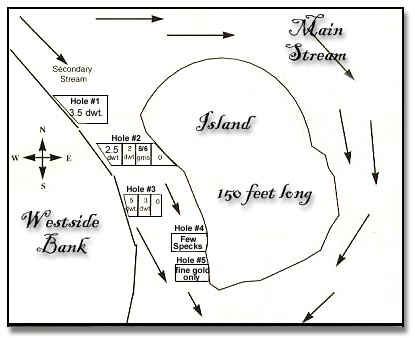 The west outside half: 2.5 dwt., and a one dwt. nugget.
The west outside half: 2.5 dwt., and a one dwt. nugget.
The west inside half: 2 dwt. of nice pieces.
The east inside half: Five to six grains of fine flood gold.
The east outside half: Almost nothing.
In Hole #3, about 40 feet below Hole #2, we decided to work the center of the creek westward. This time we decided to test three parts. The bedrock was showing in several places and the overburden wasn’t more than two feet deep, so we cleaned the bedrock without sampling midway. We found the greatest amount of gold in the middle third of the hole. All total being a little more than 5 dwt., 3.5 dwt. from the center and very little from the inside third.
In Hole #4, about 25 feet below Hole #3, we decided to test out our theory that the gold was on the west side of the creek. Again, we systematically cleaned about 60 square feet of bedrock, but this time on the east side of the creek. The results–you guessed it, almost nothing.
As Dave McCracken states in his dredging videos, when you hit pay dirt or the paystreak, the hardest thing to do is to fall back and find the tail end of the flow. In Hole #5 we dropped back another 50 feet, almost to where the little creek flows back into the main channel. Again, we started at the center and worked westward, and you guessed it. Almost the same results. The westward half of the hole proved to be the best. Total weight found was 7 dwt. We talked to the miners above and below us. There have been several nice nuggets an ounce or larger, as well as several quartz rocks with gold taken.
I have talked to many miners about sampling and recording. It is hard to believe the number of miners who play the hit or miss approach to mining. 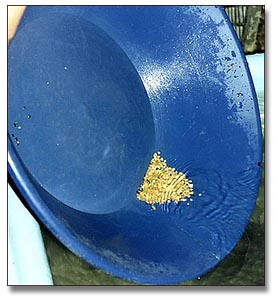
If you are out to have fun and find some gold, then sample, find gold and have fun. If you want to find a little more gold, then use a systematic approach. This approach must center around sampling and recording, sampling and recording, and more sampling.
Knowing where the gold should be does not mean that it is there, but your chances are better. Like many of you, David’s mining and mine is limited to weekends and summer vacation time. If we’re going to be productive, find gold and beat that gold bug, then our time sampling is of greatest value to us. We can plan our summer vacation in the area that has sampled out the best.
We have now sampled several locations and recorded our gold recovery. Some locations have been very interesting with good potential, and others did not prove out at all. We haven’t made our plans for next year, but we have created a fairly good picture of where the gold is, and where it isn’t. A very important first step.
If we decide to mine the creek above, guess which side of the creek we will be mining? I’ll let you know how the summer goes, but until then, remember to keep a smile on your face, your back to the wind, and watch out for that gold bug.
- Here is where you can buy a sample of natural gold.
- Here is where you can buy Gold Prospecting Equipment & Supplies.
- More About Gold Prospecting
- More Gold Mining Adventures
- Schedule of Events
- Best-selling Books & DVD’s on this Subject





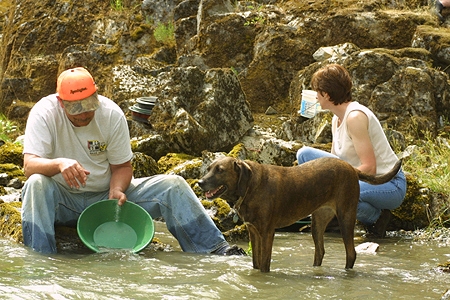
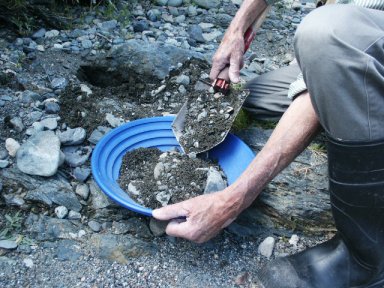
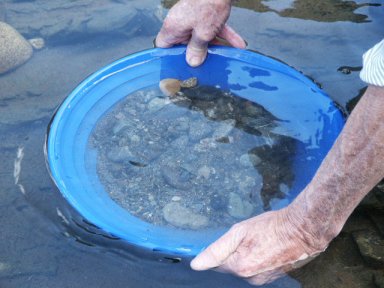
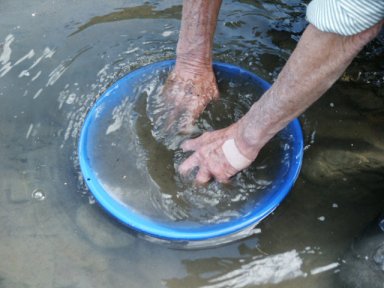
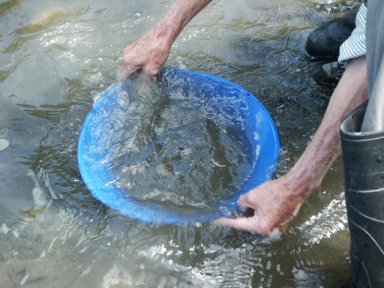
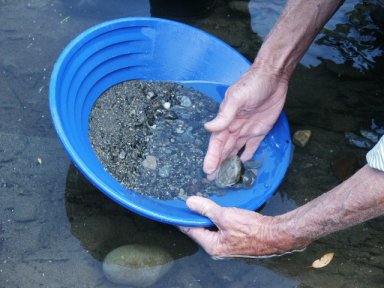
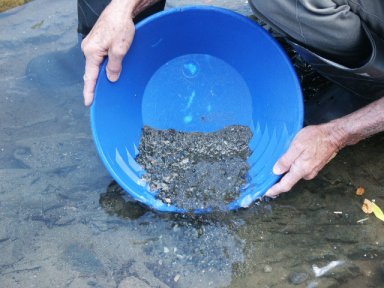
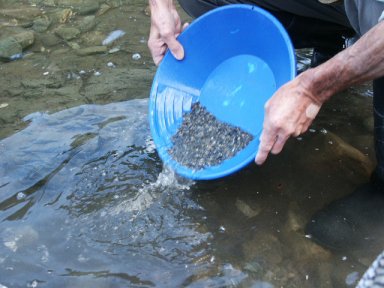
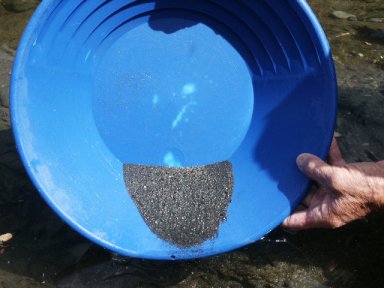
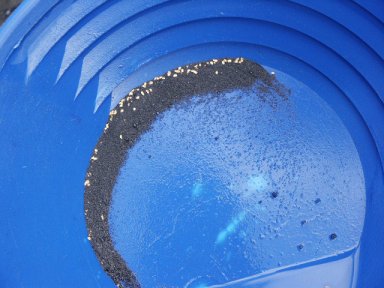
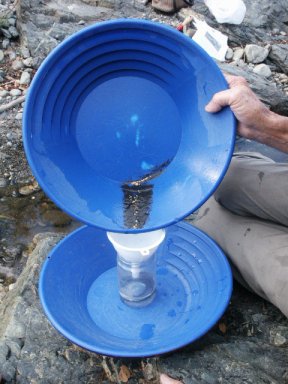
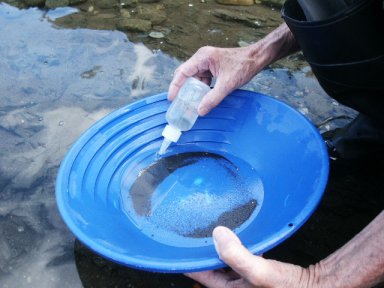
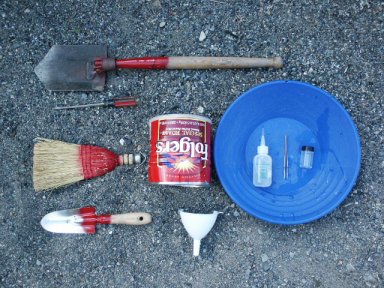


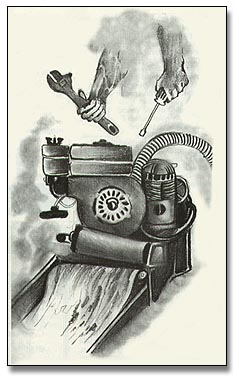 wrench, or a clamp, only to find the store just closed! Make up a small kit of tools and parts to keep with the mining equipment.
wrench, or a clamp, only to find the store just closed! Make up a small kit of tools and parts to keep with the mining equipment.
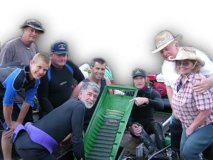
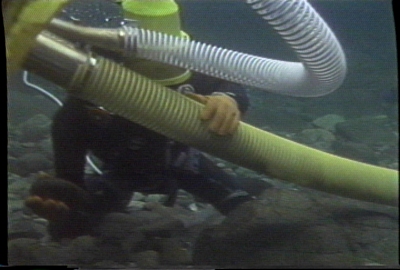 One of the main impediments to production in
One of the main impediments to production in 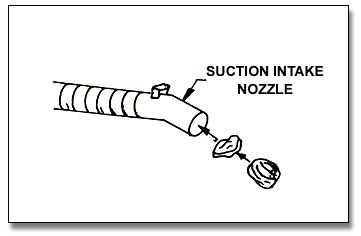 Many plug-ups occur in the power jet. These are generally caused for two reasons (in addition to sucking up the wrong rocks). The first is because of a design-flaw. Many power jets are smaller in diameter than the inside of the suction hose. Where the larger-sized suction hose meets the smaller-sized jet, there is a restriction which can cause rocks to lodge.
Many plug-ups occur in the power jet. These are generally caused for two reasons (in addition to sucking up the wrong rocks). The first is because of a design-flaw. Many power jets are smaller in diameter than the inside of the suction hose. Where the larger-sized suction hose meets the smaller-sized jet, there is a restriction which can cause rocks to lodge.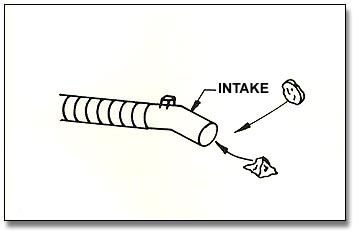
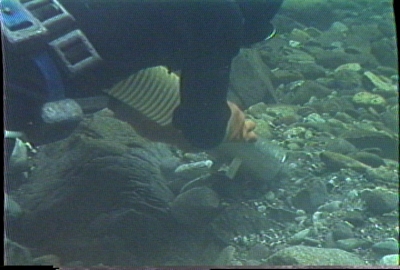 All of this unnecessary additional work will prompt you to pay more attention to what you are feeding into the nozzle! I have spent plenty of time watching beginners invest more than 50% of their day just on freeing plug-ups!
All of this unnecessary additional work will prompt you to pay more attention to what you are feeding into the nozzle! I have spent plenty of time watching beginners invest more than 50% of their day just on freeing plug-ups!


